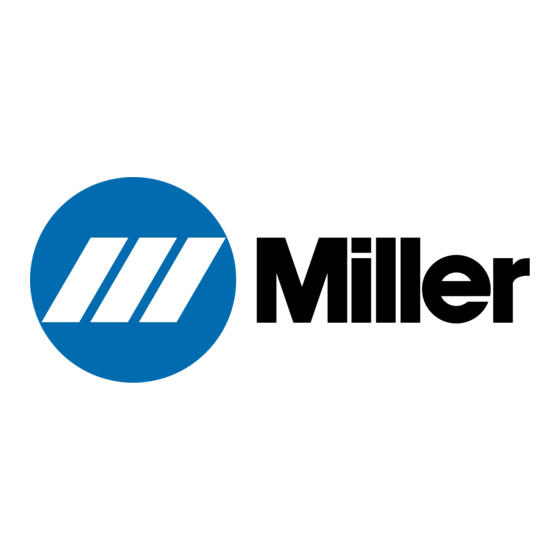Miller 900019 Manual de instalación y funcionamiento - Página 6
Navegue en línea o descargue pdf Manual de instalación y funcionamiento para Sistema de soldadura Miller 900019. Miller 900019 25 páginas.

N EVER
use
cracked,
ill-fitting,
or
defective
plates.
EC.
The
filter
glass
plate provided
in the
helmets
and
shields must be
of
reputable
manufacture conform
ing
to
the
latest
USA
Standard
Z2.1.
Replace
cracked
or
ill-fitting
filter
plates
promptly.
NEVER
use
filter
plates
without
a
protecting
cover
glass.
ED.
Keep
a
clean
cover
glass
in
front of
the filter
plate
for the
protection thereof.
Frequent
renewal
of
these
cover
glasses
is
necessary, since
they
become
covered
with
spatter,
reducing
vision.
1.22. CLOTHING
NEVER
use
poor,
inadequate,
or
worn-out
cloth
ing.
Wear
heavy shoes, tightly
laced.
Keep
clothing dry.
EA.
Proper
and
dry,
oil-free
clothing
is essential
for
the
welders
protection.
Clothing
must not
only
keep
off the
spatter
and molten
particles,
but must
also abstruct the
rays of the
arc
and,
when
nec
essary,
insulate the
body
from harmful electrical
currents.
EB.
Wear
leather
or
asbestos
gloves
at all times to
protect
the hands and
wrists.
Dark colored shirts
are
preferred
to
light
ones
because
light
ones
reflect
arc
rays
to
exposed parts
of the
body.
In
the
case
of gas shieldedarc
welding, light
colors
are
more
reflective
and may
cause
eye burns due
to
the
intense
ultraviolet
rays
given
off
by
the
process. Avoid cotton
fabrics
when
gas shielded
arc
welding.
EC.
An
arc
burn
on
the
skin
resembles
a
sunburn,
except
that it is
usually
more
severe.
Clothing
can
be
made
flame
resistant
by
treatment
with
a
solution of
3/4
pound
of
sodium stannate in 1
gal
lon
of
water,
then
wrung
out
and
dipped
in
a
solution of
1/4 pound
ammonium
sulphate
per
gal
lon of
water.
Dont
wash
clothing
so
prepared
in
water,
but
dry
clean.
ED.
When
welding
operations
are
to be
performed
in
vertical and overhead
positions,
leather
sleevelets,
aprons, and in
some
cases
leggings
and
ear
plugs
should be used to
prevent
severe
burns
from
spatter
and molten
metal.
1.23. HOT METAL BURNS
NEVER
pick
up hot
objects.
EA.
Never
pick
up
pieces
of metal which
welded
or
heated,
or
the stub ends
which have been
discarded.
1.24. GRINDING AND CHIPPING
EA.
Whenever
it is
necessary
to
grind
or
chip metal,
wear
protective
goggles specifically designed
for
this
purpose.
Serious
eye
injuries
may
result
from failure
to
wear
protective
goggles.
NEVER
do any
chipping
or
grinding
without pro
tective
goggles.
1.25. COMPRESSED GAS CYLINDERS
NEVER
strike
an
arc on
compressed
gas
cylin
ders.
EJA.
Avoid accidental contact of the
electrodes,
electrode
holder,
or
other
electrically energized
parts
with
a
compressed
gas
cylinder
or
any other pressure
vessel.
Serious
accidents
or
fires
may
result.
EB.
Use
I.C.C.
cylinders. They
are
manufactured
and
maintained in accordance with
I.C.C.
requirements
and
are
safe
so
long
as
they
are
properly
handled.
Dont
drop cylinders.
EC.
Identify
gas
content
by
the
name
marked
on
the
cylinder.
If the
cylinder
is
unmarked,
do not
use
it.
Return it
to the
supplier.
Do not
rely
on
color
code.
ED.
Never
use a
cylinder
or
its
contents for other than
intended purposes.
EE.
Keep
oil and
grease away from oxygen
cylinders
and
cylinder
valves.
EF.
Keep
cylinders
away from
exposure to
sparks,
hot
slag,
open
flame
and
all
possible
sources
of
ignition
or
excessive
heat.
EG.
Be careful that
cylinders
are
not
placed
so
as
to
become
a
part
of
an
electrical
circuit.
Avoid
third
rails,
wires
and electric
welding
circuits.
EH.
When
transporting cylinders by
crane,
use
cradle,
platform
or
other suitable
support.
El.
Never lift the
cylinders by
slings,
by
the caps
or
by
electric
magnets.
EJ.
Never
use
cylinders
as
supports
or
rollers.
EK.
Never
try
to mix any
gases
in
a
cylinder.
EL.
Never
try
to refill
a
cylinder.
EM.
Mark
empty cylinders Empty
or
MT.
EN.
Send
Emptys
back
to
the
supplier promptly.
EO.
Keep
Emptys
and Fulls
separate.
EP.
Never
tamper
with
or
alter
cylinder
numbers
or
other
markings.
This
is
not
only
foolish
but
may
be
illegal.
EQ.
Do not
tamper
with
or
change
fittings
on
cylinders.
ER.
If
valves
cannot
be
opened by hand,
do not
use
hammer
or
wrench.
Notify supplier.
ES.
Protect
cylinder
valves
from
bumps, falls,
falling
objects,
and
from
weather.
Keep
them covered
with
cylinder
caps when
moving cylinders.
LIT.
Keep
valves closed
on
empty cylinders.
EU.
See that your
cylinders
are
clear of
passageways
and active work
areas
and that
they
are
secured
against
falling.
LIV.
If
adapter
is
required
between
cylinder
an~l
reg
ulator, always
use a
standard
adapter.
These may
be obtained from your
supplier.
Where
right
and
left
hand
threads
are
used
on
adapter,
use
two
wrenches to insure leak
proof
connections.
EW.
Do
not
store
cylinders
in
unventilated
areas.
1/
~
have
just
been
of electrodes
Page
4
